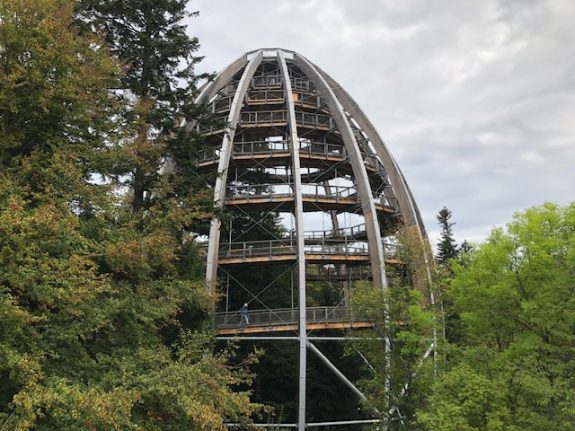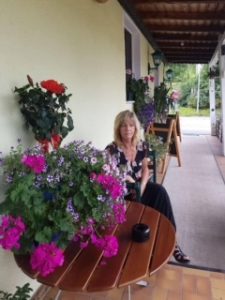A walk in the forest

Bayerischer Wald can be just as hard to get to than it is to pronounce.
For we folk who are only fluent in English there is a translation just for us: the Bavarian Forest. But it any language, it is still hard to get to.
Nonetheless, we were determined to get there.
Departing from Munich, reaching our destination required three trains to Grafenau before taking a taxi to the nearby and stunningly beautiful little village called Neuschönau, nestled near the forest and not too far from the border with Czechia.
Catching connecting trains in Germany presents a challenge we Australians are not too familiar with: the trains run on time.
Our first connecting train gave us a whole two minutes to scamper from one platform to the one over the other side. The second connecting train was far more generous, giving us a whole four minutes.
We discovered two things about trains in Germany: 1) If the timetable says the train is due in at, say, 10:26am then it arrives at 10:26am and not a minute earlier or a minute later, and 2) If the timetable says the train is due to depart at 10:28am, then it departs at 10:28am on the dot.
I could add a third: travel lightly. It’s rather awkward running as fast as you can to opposing platforms with a suitcase that weighs roughly the same as a small motor car, and then to find that the connecting train has nowhere for you to place it.
But all the running, huffing and puffing is worth it when you finally arrive at your hotel, which in our case was a drop-dead gorgeous old villa with million-dollar views from our room.
Mine host, Manuel, was a friendly enough sort of chap, though he gave me another reason to travel lightly; mumbling at me over the weight of our suitcases which he’d volunteered – with regrets – to carry up the stairs for me.
But we were in Neuschönau, and it was time to explore.

Liz (Photo from Facebook)
We didn’t get far. Liz’s Restaurant and Café, about a ten-minute walk from our hotel, beckoned us. Liz – a lovely English lady originally from the Channel Islands – married a German and returned with him to Neuschönau, in her words; “a lifetime ago”.
For Carol and I, who know only a handful of German words Liz was soon our go-to person while staying in the village. (Which was handy, as her little restaurant had food to die for. Her square chips alone are worth travelling to Germany for.)
As an aside, Liz mentioned that Carol and I were only the second lot of Australians to visit her little restaurant. A young couple from Melbourne were there six months earlier. It gave us the hint that Neuschönau was well off the beaten track when it came to tourists. (Away from the bustling crowds is worthy of a koala stamp.)
But we were only there for one reason: to visit Bayerischer Wald.
Manuel, bless him, gave us two return trip bus passes to the forest, so after a 15-minute walk to the bust stop our adventure was soon to begin. After a very short trip the bus driver gave us a nod that said; “We’re here”. (Little had we realised that the forest was within walking distance from the village.)
Alighting our bus, to our left was a tree-top walk, on the right, the forest itself. We went left, enticed by a massive tower that rose above the forest.
We needed a good hour to complete the tree-top and tower walk.

When you see something like this… you just want to check it out.

Part of the tree-top walk that heads towards the tower.



To give you an idea of the size of the tower, that small dot in the middle of the photo is Carol. The photo was taken from level 3.

Inside looking up.
With the tree-top walk done a dusted, we headed to the forest, unaware that we were about to embark on one of the most exhilarating days imaginable. Amazing wildlife, breathtaking scenery – the forest had it all.
It didn’t take long to meet one of its inhabitants: a startled red squirrel, who upon seeing me, sprinted off at roughly 750ks an hour. I kid you not.

Our first encounter on our forest walk: a European bison. The last thing we expected to see was a bison, which until that moment we had no idea that the creature even existed.


The forest is painted with vibrant colours.

If the sight of a bison was a surprise, then so too were the moose.

What looked like a small tiger is actually a lynx.

An “uhu” (German for “European eagle owl”) camouflaged in the rocks. The talons on this magnificent bird were as large as my hands.

It’s a bear! In the woods!

A welcome sign for weary legs. Forest walk done, the ‘red carpet’ is rolled out for the last few hundred metres.
The forest walk took us roughly six hours. If we could have pressed on for an extra hour we would have been rewarded with encounters with elk and boars, but the legs said “no”.
Apart from the wildlife we’d captured on film, we also encountered a wolf, some martens and beavers (who were making their home in readiness for Winter). The animals, unfortunately, were too quick for our cameras. The wolf, however, was just plain stubborn: refusing to come out from behind the bush were first spotted.
Finishing the day at Liz’s – and stories of our adventure – we vowed that we’d return if ever the opportunity would present itself.
”If ever you do,” said Liz, “promise me you’ll catch a train to Passau just north of here. It’s too beautiful not to see, and then you can catch a taxi to Neuschönau. Or you could have just taken a bus from Munich to here.”
What! There’s an easy way to get to Neuschönau! Now you tell us!
Yeah, but nah. The hard way was fun.
Carol and I visited Bayerischer Wald in September 2018. To this day, we haven’t forgotten a second of it.
(More photos here of the magical forest).
Like what we do at The AIMN?
You’ll like it even more knowing that your donation will help us to keep up the good fight.
Chuck in a few bucks and see just how far it goes!
Your contribution to help with the running costs of this site will be gratefully accepted.
You can donate through PayPal or credit card via the button below, or donate via bank transfer: BSB: 062500; A/c no: 10495969










12 comments
Login here Register here-
Andrew Smith -
Anne Naomi Byam -
Michael Taylor -
Denis Bright -
Terence Mills -
leefe -
Michael Taylor -
Michael Taylor -
Michael Taylor -
Roswell -
leefe -
GL
Return to home pageLooks good! Yes, state railways in Oz could replicate much of what Germany and Europe have in trains inc. replacing XPT with the Austro-Czech RailJet
Loved this Michael … what a phenomenal place to visit. Sounds like one might need to train fairly well beforehand, to get through the entire walk. Thanks for sharing your personal travelogue – has made my day. Also, your photography is stunning.
Thank you, Anne. Though I must give Carol credit for the moose photo.
Much more exciting Michael than my own jaunts into the forests of Germany and the Czech Republic: Keep planning more adventures
Michael
Got me thinking, seeing that group of Mooses, what is the plural for words like “moose” does it follow those like “tooth,” “foot”, and “goose”.
Well, we know that they are teeth, feet and geese so logically the plural of moose is meese, right ?
On further analysis it becomes apparent that moose was adopted from the native American where meese are native and those languages don’t pluralise (or pluralize), so moose it is, like deer.
Just as well they didn’t have any platypuses or is it platypi or “platypodes” ?
Since Terrence has has switched on my pedant mode:
a) it’s either platypuses or platypodes. Platypi is right out. Platypus is greek (flat foot); you can’t craft a Latin ending onto a Greek word. But you probably already know that.
b) Michael, do you mean martens or martins? The first is a mammal, the latter a bird (similar to a swift).
The wildlife is impressive.
Oops. Martens. I’ll fix it immediately.
Thanks for picking that up. 👍
Terry, you’re really going to confuse a Scot, who might think you’re talking about a mouse.
“There’s a moose loose in the hoose.”
Back in the 1960s we learnt at school it was platypii and hippopotamii.
But I’ve never heard of them being called those names since.
(Gawd knows what a cross between a platypus and a hippopotamus would have been called).
I’ve been to the Black Forest, but not this one. Until now I’d never heard of it. It looks fabulous.
Gawd, I’m still trying to think what a cross between a platypus and hippopotamus would look like … web-footed, duck billed, river horse …
leefe,
Put a duck bill on Bananababy and there you go.